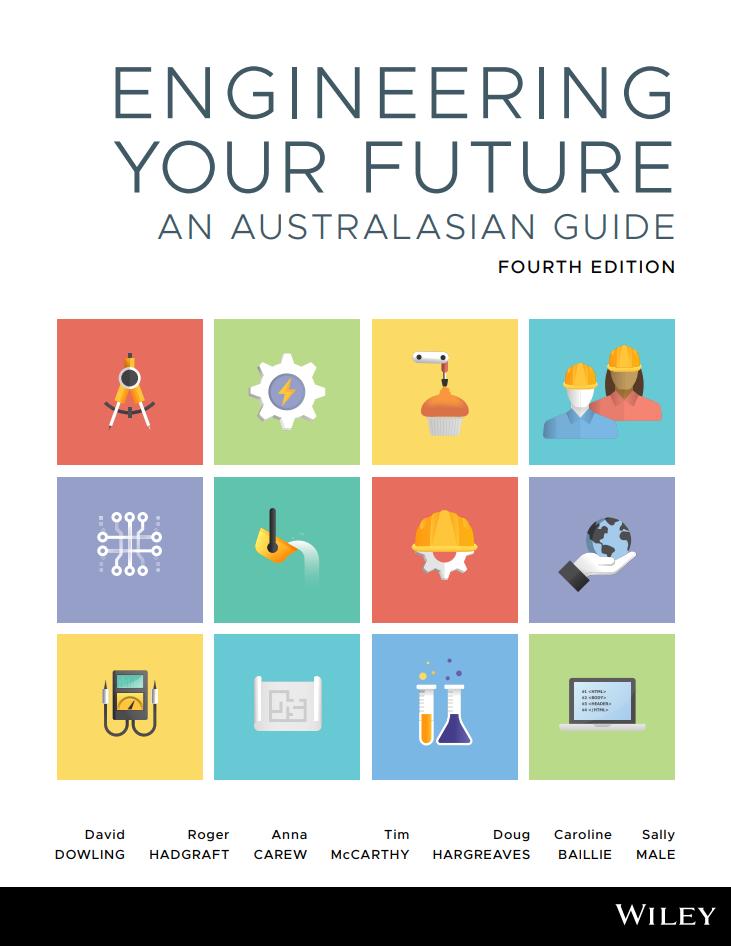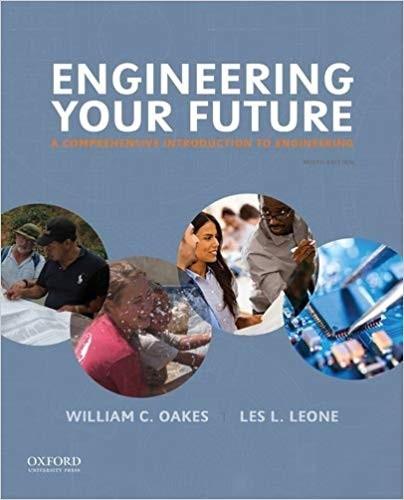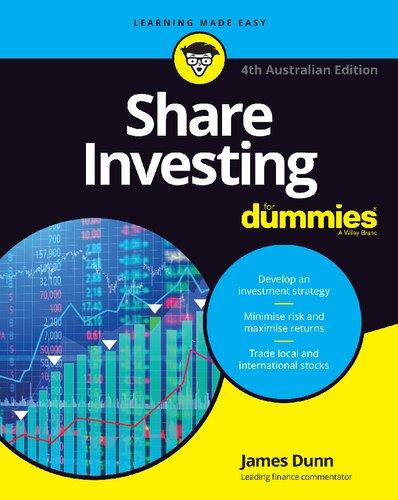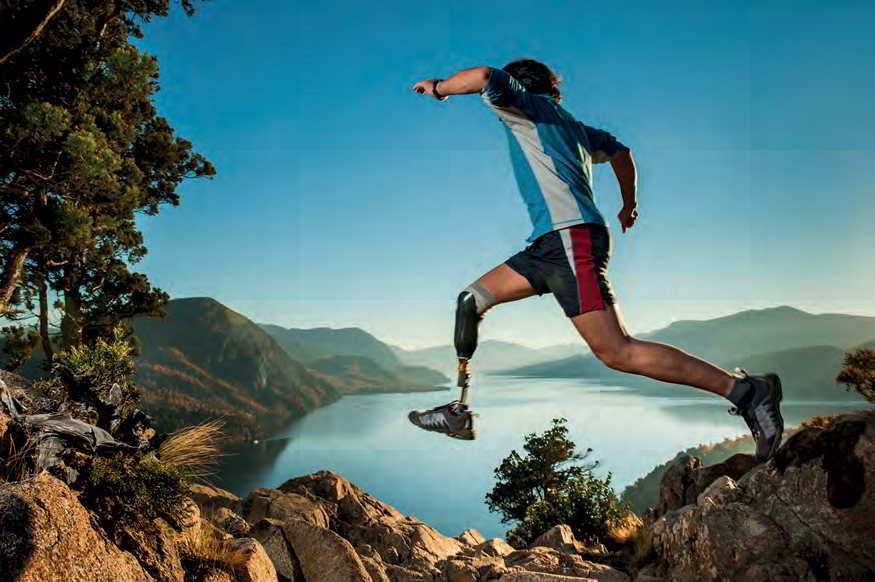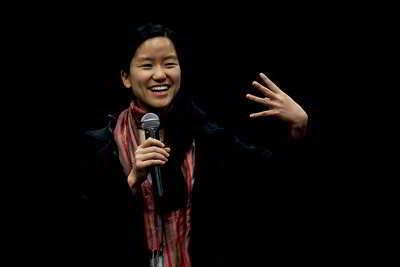Visit to download the full and correct content document: https://ebookmass.com/product/engineering-your-future-an-australian-guide-4th-editio n-david-dowli/
More products digital (pdf, epub, mobi) instant download maybe you interests ...
(eTextbook PDF) for Engineering Your Future A Comprehensive Introduction to Engineering 9th Edition
https://ebookmass.com/product/etextbook-pdf-for-engineering-yourfuture-a-comprehensive-introduction-to-engineering-9th-edition/
Engineering Your Future: A Comprehensive Introduction to Engineering 9th ed. Edition William C. Oakes
https://ebookmass.com/product/engineering-your-future-acomprehensive-introduction-to-engineering-9th-ed-edition-williamc-oakes/
Unlocking Small Business Ideas: An Australian Guide John W. English
https://ebookmass.com/product/unlocking-small-business-ideas-anaustralian-guide-john-w-english/
An Introduction to Mechanical Engineering (4th Ed.) 4th Edition Jonathan Wickert
https://ebookmass.com/product/an-introduction-to-mechanicalengineering-4th-ed-4th-edition-jonathan-wickert/
Tomorrow's Lawyers: An Introduction to your Future (Third Edition) Richard Susskind
https://ebookmass.com/product/tomorrows-lawyers-an-introductionto-your-future-third-edition-richard-susskind/
Interventional Radiology: A Survival Guide 4th Edition
David Kessel
https://ebookmass.com/product/interventional-radiology-asurvival-guide-4th-edition-david-kessel/
Even You Can Learn Statistics and Analytics: An Easy to Understand Guide 4th Edition David Levine
https://ebookmass.com/product/even-you-can-learn-statistics-andanalytics-an-easy-to-understand-guide-4th-edition-david-levine/
Even You Can Learn Statistics and Analytics: An Easy to Understand Guide, 4th Edition David M. Levine
https://ebookmass.com/product/even-you-can-learn-statistics-andanalytics-an-easy-to-understand-guide-4th-edition-david-m-levine/
Share Investing For Dummies 4th Australian Edition
James Dunn
https://ebookmass.com/product/share-investing-for-dummies-4thaustralian-edition-james-dunn/
ENGINEERING YOUR FUTURE AUSTRALASIAN GUIDE FOURTH EDITION David DOWLING Roger HADGRAFT
Anna CAREW
Tim Mc CARTHY
Doug HARGREAVES
Caroline BAILLIE
Sally MALE
Engineeringyour future:an Australasianguide FOURTHEDITION DavidDowling
RogerHadgraft
AnnaCarew
TimMcCarthy
DougHargreaves
CarolineBaillie
SallyMale
Fourth edition published 2020 by John Wiley & Sons Australia, Ltd
42 McDougall Street, Milton Qld 4064
Typeset in 10/12pt Times LT Std
© John Wiley & Sons Australia, Ltd 2010, 2013, 2016, 2020
The moral rights of the authors have been asserted.
A catalogue record for this book is available from the National Library of Australia.
Reproduction and communication for educational purposes
The Australian Copyright Act 1968 (the Act) allows a maximum of 10% of the pages of this work or where this work is divided into chapters one chapter, whichever is the greater, to be reproduced and/or communicated by any educational institution for its educational purposes provided that the educational institution (or the body that administers it) has given a remuneration notice to Copyright Agency Limited (CAL).
Reproduction and communication for other purposes
Except as permitted under the Act (for example, a fair dealing for the purposes of study, research, criticism or review), no part of this book may be reproduced, stored in a retrieval system, communicated or transmitted in any form or by any means without prior written permission. All inquiries should be made to the publisher.
The authors and publisher would like to thank the copyright holders, organisations and individuals for the permission to reproduce copyright material in this book.
Every effort has been made to trace the ownership of copyright material. Information that will enable the publisher to rectify any error or omission in subsequent editions will be welcome. In such cases, please contact the Permissions Section of John Wiley & Sons Australia, Ltd.
Wiley
Terry Burkitt (Director, Publishing and Course Development), Lori Dyer (Senior Publisher), Kylie Challenor (Senior Manager, Knowledge & Learning Content Management), Rebecca Campbell (Production Editor), Tara Seeto (Publishing Coordinator), Emily Brain (Production Assistant), Renee Bryon (Copyright & Image Research), Delia Sala (Cover Design)
Cover images: © Enis Aksoy / Getty Images Australia
Typeset in India by diacriTech
Printed in Singapore by Markono Print Media Pte Ltd
10 9 8 7 6 5 4 3 2 1%%%%%
BRIEFCONTENTS Abouttheauthorsix Prefacexii
PART1Introductiontoengineering 1
1.Whatisengineering?2
2.Theengineeringmethod43
PART2Engineeringinsociety 84
3.Sustainableengineering85
4.Professionalresponsibilityandethics128
PART3Professionalskills 164
5.Self-management165
6.Workingwithpeople206
PART4Communication 246
7.Understandingcommunication247
8.Communicationskills285
PART5Applyingtheengineeringmethod 330
9.Understandingtheproblem331
10.Engineeringdesign382
11.Evaluatingoptions422
12.Engineeringdecisionmaking448
13.Managingengineeringprojects478
14.Communicatinginformation521
PART6Planningyourcareer 569
15.Yourengineeringfuture570
Index600
aposition79
Otherengineeringdisciplines16
Thecoreskillsandattributesofan 1.3 engineer17
TheEngineersAustraliacompetency framework18
PART2 84 Engineeringinsociety CHAPTER3
Introduction86 3.1Whatisecologicallysustainable development(ESD)?88 DefinitionsofESD89 92 Whatissustainableengineering? Whysustainableengineering?93 Strategiesforpractisingsustainable 3.2 engineering95
Constraintsofsustainableengineering practice98 Triplebottomlineanalysis(TBLA)100 Environmentallysustainable 3.3 engineering100
Sociallysustainableengineering 3.4
Promotingintergenerationaland intragenerationalequity110
Maslow’s hierarchy of needs 112
Communitycommunicationand consultation113
Multi-criteriadecisionanalysis(MCDA) 114
Engagementtechniques116
3.5Economicallysustainable engineering117
Costing117
Economictheories118
Leastcostplanning(LCP)118
Summary121
Keyterms122
Exercises123
Projectactivity124
References124
Acknowledgements126
CHAPTER4
Professionalresponsibility andethics128 Introduction129
4.1Professionalresponsibility:standards andprofessionalliability130
4.2Workhealthandsafety(WHS)and personalliability133
Productrecall137
4.3Engineeringethics138
TheEngineeringNewZealandCodeof EthicalConduct140
TheIEEECodeofEthics141
Interpretingandapplyingcodesof ethics142
4.4Ethicaltheories143
Moralsandethics143
4.5Commonethicaldilemmasin engineering147
Microethics148
Balancingconflictinginterests151
4.6Macroethics154
4.7Cultureandcorruption155 Internationalbusinessetiquette156 Corruptionandbribery156
Summary159
Keyterms160
Exercises161
Projectactivity162
References162
Acknowledgements163
Introduction166
5.1Understandingself168
Yourpersonalityandattitudes168
Spatialability171
5.2Whatmotivatesyou?172
Sourcesofinspiration176
5.3Developingyourskills178
Developinganinquiringmind178
5.4Self-managementskills181
Developinggoalsandstrategies181 Beingresponsible181 Beingprofessional181
Managingyourtimeeffectively182
5.5Life-longlearning183 Knowledgeframeworks186 Theprogramframework187
Managingyourlearning189
5.6Reviewingyourperformance196 Levelsofreflection199
Kolb’sLearningCycle199 Summary201
Keyterms202
Exercises202
Projectactivity203 References203 Acknowledgements205
CHAPTER6 Workingwithpeople206
Introduction207
6.1Collaboratingwithothers208
6.2Workingingroups214
Establishingagrouporteam215
Thefundamentalsofaneffective group217
Thelifecycleofateam220
Improvingperformance221 Leadership223
Thebenefitsofworkingwithothers224
6.3Meetings225
Thepurpose225
Thestyle228
Thetiming228
Thelengthofthemeeting228
Theparticipants228
Theprocedures228
Yourcontribution229
Organisingameeting229
Theroleoftechnologyinmeetings232
Thedownsideofworkingwith others232
6.4Negotiation235
Thepreparationprocess235 Approachestonegotiation236 Outcomesofthenegotiation process238
6.5Disputeresolution239 Conflictresolution240 Summary241
Keyterms242 Exercises242
Projectactivity243
References243
Acknowledgements244
PART4 Communication246
CHAPTER7
Understanding
communication247
Introduction248
7.1Whatiscommunication?249
Keycommunicationskillsforengineers251
7.2Communicationtheoriesandmodels252
Thecommunicationprocess253
Acontemporarymodel254
Developingacommunicationmodelfor engineers255
7.3Communicationcontexts259
Characteristicsofcommunicators260
Environments264
Digitalcommunication266
7.4Communicationmethods270
Channels270
Communicationlanguages270 Noise272
7.5Communicationroles275
Thecreator275
Thegatekeeper278
Theconsumer279
Summary281
Keyterms282
Exercises282
Projectactivity282
References283
Acknowledgements284
CHAPTER8
Communicationskills285
Introduction286
8.1Verbalcommunicationskills291
Listening292
Telling293
Discussing293
Informalverbalcommunication294
8.2Formalverbalcommunication296
Mediareleases,interviewsand publicity296
Presentations297
Workingtopresentationtimelimits298
Thepresentationcontexts299
Contentandstructure300
Selectingandpreparingmedia301
Assemblingandrehearsingthe presentation302
Isapprovalrequired?303
Presentingthroughwordsandaction303
Answeringquestions304
8.3Writtencommunicationskills304
Reading304
Writing305
Wikis311
Webpages311
8.4Visualcommunication312
Data312
Summary327
Keyterms327 Exercises328 References328
Acknowledgements329
PART5 Applyingtheengineering method330 CHAPTER9 Understandingthe problem331 Introduction332
9.1Data,informationandknowledge334 Data334 Information340 Knowledge340 Differentiatingbetweendata,informationand knowledge341
9.2Identifyinginformationneeds343 Investigativequestioning343 Categoriesofinformation345 Organisinginformationneeds345
9.3Locatingandretrievinginformation348 Typicalsourcesofengineering information348 Documents349 Colleagues351 Stakeholders353 Geographicinformationsystems357 Librarysearchtools359 Internetsearchtools360 Developingasearchstrategy360 Recordingdataaboutinformation sources364
9.4Evaluatinginformationandinformation sources364
Evaluatinginformationsources364 Evaluatinginformation365 Refininginformationneeds366
9.5Managingandusinginformation366 Integratinginformation367
Publishinginformation368 Aliteraturereview368
Aninformationmanagementsystem368 Controllingaccesstoyourinformation371
9.6Citingandreferencing373
Listingandcitingprintreferences373
Listingandcitingonlinereferences375
Furtherinformationaboutreferencing styles376
Summary377
Keyterms378
Exercises378
Projectactivity378
References380
Acknowledgements381
CHAPTER10 Engineeringdesign382 Introduction383
10.1Design = problemsolving384
Keyideasinthedesignprocess384
10.2Systemsthinking387
Stakeholders389
Socio–ecologicalthinking392
Wholesystemdesigngoals393
Wholesystemdesignelements396
10.3Generatingalternativesolutions404
FiveWsandanH404
Research405
Brainstorming406
Lateralthinking,parallelthinkingandthesix thinkinghats407
Synectics410
TRIZ412
Transformingdesignthroughbiomimetic thinkinganddesign414
Summary417
Keyterms417
Exercises418
Projectactivity418
References419
Acknowledgements420
CHAPTER11 Evaluatingoptions422 Introduction423
11.1Evaluatingsolutions—economics423
Non-economiccriteria424
Qualitativeapproachestoproject evaluation424
Economicfeasibility425
Sensitivityanalysis431
Amoredetailedeconomicmodel432
11.2Technicalfeasibility436
11.3Mathematicalmodellingindesign438
Poweroutput439
Maximisingenergyproduction440
Safety442
Checking443
Hierarchyofmodels443
Summary445
Keyterms445
Exercises445
Projectactivity446
References446
Acknowledgements447
CHAPTER12 Engineeringdecision making448 Introduction449
12.1Engineeringdecisionmaking449
Engineeringdecisionsupport450
12.2Complexity452
Staticanddynamicproblems452
12.3Team-baseddecisionmaking453
Effectiveteamenvironment455
Dominanceandpower455
Diversityinteams456
Makingbetterdecisionmakers457
12.4Reviewingkeydecision-making criteria460
Uncertainty460
Environment460 Ethics460
Safety461
Reviewandimprove—quality assurance461
12.5Decisionsupportsystems,toolsand techniques463 ‘Penandpaper’decisionsupporttools463 Computer-basedDSS465 NetworkedDSSrelyingoncommunications technology467 IntelligentDSS(IDSS)471 GIS-basedDSS472 Summary475 Keyterms475 Exercises476
Projectactivity476
References476
Acknowledgements477
CHAPTER13 Managingengineering projects478 Introduction479
13.1Understandingprojectmanagement480
Keyfactorsinprojectmanagement481
TheProjectManagementBodyofKnowledge (PMBOK)andprojectmanagement standards481 Projectmanagementtools485
13.2Planningthestagesofanengineering project488
Usingatooltoplantheprojectstages489
Planningthestagesofthegreen-starbuilding project492
Humanresources500
Financialresources502
13.3Creatingarisk-managementplan503
Dependencyrisks504
Designrisks505
Constructionrisksandsafety505
Internalprojectrisks507
Long-termrisksforthegreen-star building508
13.4Developingaknowledgemanagement plan508
Documentstorage,archivinganddata mining509
Sharingknowledge509
Communitiesofpractice510
Studentknowledgemanagement511
13.5Qualitymanagementanditsrelationship toprojectmanagement511
Keyqualitymanagementprinciples512
Engineeringqualitymanagement513
Qualityplansandengineering514
Qualityandtheengineeringstudent515
Qualityandstudentteamprojects516
Summary517
Keyterms517
Exercises518
Projectactivity519
References519
Acknowledgements520
CHAPTER14 Communicatinginformation 521 Introduction522
14.1Threecommunicationcontexts523
Thebusinesscontext524
Thedisciplinecontext524
Thepubliccontext525
14.2Planningacommunication527
UsingthePCRmodeltocreateeffective communication527
Developingacommunicationplanforan engineeringproject528
Usingthemodel529
Approach529
Communicationmethods,styles,formats andmedia531
14.3Writingintheengineering workplace531
Practicenotes533
Businesscorrespondence534
Humanresourcedocuments535
Financialdocuments539
Projectinitiationdocuments541
Riskmanagementdocuments547
14.4Technicalpresentations553
Howcanpoorpresentationbe avoided?553
14.5Visualcommunication555
Drawings,plansandsketches556
Photography557
Engineeringmodels557
Summary566
Keyterms567 Exercises567
Projectactivity567
References567
Acknowledgements568
CHAPTER15 Introduction571
15.1Engineeringtomeetfutureglobal challenges572
Antibioticresistance572
Climatechangeadaptation576
15.2Engineeringandglobalisation581 EmploymentinAustralia581 Globalisation582
Developmentandpostdevelopment583
15.3Futuristicengineering:emerging fields584
Industrialbiotechnology585 Materialsscience585
Phytomining586 Biomimicry587 Animatronics588
15.4Anengineeringcareer589
Worktorule—orbeinspiredtowork towardsafulfillingcareer590
Managementapproaches590
Differenttypesofengineering organisations591
Efficiencyandrespectintheworkplace591
Continuingprofessionaldevelopment(CPD) 592
Careerplanning593
Summary595
Keyterms595
Exercises596
Projectactivity597
References597
Acknowledgements598
Index600
ABOUTTHEAUTHORS DavidDowling
DipLSurv,ARMIT,BAppSci,MSurvMap,FIEAust
HonoraryProfessorofEngineeringEducation
FacultyofEngineeringandSurveying,UniversityofSouthernQueensland
DavidDowlingispassionateaboutfacilitatingstudentlearningandhelpingengineeringstudentstoachieve theircareergoals.Consequently,muchofhisworkandresearchisfocusedonworkingwithindustry representativestodeveloppractice-basedcurriculaandtoenhanceteachingandlearningenvironments. Recentlyhisfocushasbeenon:facilitatingstudenttransitiontouniversity;identifyingandaddressing factorsthatinfluencesuccessatuniversity;assessingworkplacelearning;workingwithpractitioners todefinegraduateattributes;embeddinggraduateattributesintoprogramcurricula;andengineering technicianeducation.
Davidworkedasasurveyorfor12yearspriortoacceptingalecturingpositionattheUniversityof SouthernQueensland(USQ)in1978.DavidwasappointedHeadofSurveyingin1989andworked intensivelywithindustryorganisationstodesign,developandgainaccreditationforthreenewdistance educationprogramsinsurveyingandGIS—thefirstinAustralia.
In1995,heacceptedtheroleofAssociateDean(Academic)intheFacultyofEngineeringand Surveying;apositionhehelduntil2009.Hismajorachievementinthisrolewasthesuccessful2001 accreditationofthefirstAustralianBachelorofEngineeringtobeofferedbydistanceeducation.In2005, Daviddevelopedthecontent,structureandstudymaterialsfortheinnovativeMasterofEngineering Practiceprogram.ThisdistanceeducationprogramisaccreditedbyEngineersAustraliaandenables experiencedEngineeringTechnologiststobecomeProfessionalEngineersbyusingtheirworkplace learningtodemonstratetheircompetence.
From2009to2015,DavidledtwomajorprojectsfundedbytheOfficeofLearningandTeachingand wasamemberoftheprojectteamonthreeotherprojects.HehasbeenamemberofEngineersAustralia’s NationalArticulationCommitteesince2006andamemberoftheAustralasianAssociationforEngineering Education(AAEE)since1998,servingasPresidentduring2005and2006.
In2006,DavidreceivedtheAAEEExcellenceinEngineeringEducationAwardforInclusiveTeaching, andin2008hereceivedanAustralianLearningandTeachingCouncil(ALTC)Citationwhichread: For sustainedleadershipinusinggraduateattributestodesignanddeliverprograms,coursesandresources thatenhancestudents’learningandtheirachievementofcareergoals.
WhenDavidretiredin2015,heacceptedanappointmentasanHonoraryProfessorattheUniversityof SouthernQueensland.Thisallowshimtocontinuehisresearchinengineeringeducationtopicsthatenable studentstoachievetheircareergoals.Healsoconsultswithengineeringorganisationstohelpthemdefine anddevelopthepersonalandprofessionalcapabilitiestheiremployeesneedtohaveasuccessfulcareer.
RogerHadgraft
BE(Hons),MEngSc,DipCompSc,PhD ProfessorandDirector,EducationalInnovation,UniversityofTechnologySydney
RogerHadgraftisacivilengineerwithmorethan25yearsofinvolvementinimprovingengineering education.Hehaspublishedmanypapersonproblem-andproject-basedlearning(PBL),andtheuseof student-centredlearningtomeettheneedsofengineeringemployers.Hewasinstrumentalinintroducing aproject-basedcurriculumincivilengineeringatMonashUniversityin1998andincivil,chemicaland environmentalengineeringatRMITbetween2003and2006.RogerhasconsultedonPBLtouniversities bothnationallyandinternationallyandiscurrentlyleadingchangeatUniversityofTechnologySydney (UTS),transformingtheengineeringcurriculausingstudiostodeliverinnovative,design-ablegraduates.
AnnaCarew BSc(Hons),PhD CourseCoordinator,UniversityCollege,UniversityofTasmania In1996,AnnaCarewwasawatermicrobiologistandbeganworkingwithengineerstoresearchnovel microbialindicatorsofwaterandwastewaterquality.Havingrealisedengineeringwassuchapowerfuland
fascinatingfield,shemovedintoindustrialtraining,andthenresearchconsultancyinsustainablewaterand wastemanagementwiththeInstituteforSustainableFutures,UTS.ApassiontoeffectchangeledAnna toundertakeherPhDattheUniversityofSydney,investigatingtheteachingandlearningofsustainability inengineering(2005).In2011,AnnawasawardedanAustralianLearningandTeachingCouncil(ALTC) Citationforheroutstandingcontributiontotheteachingandlearningofgraduateattributesinengineering. Atthattime,AnnawantedanewchallengesoshejoinedtheTasmanianInstituteforAgricultureatthe UniversityofTasmaniatorefocusontechnicalresearchandcompletedasecondPhDonthemarvellous fusionofmicrobiology,chemistryandbioprocessengineeringthatispinotnoirwinemaking(2015).
Annanowmanagesateachingteamdeliveringshortcourses,DiplomasandAssociateDegreesinapplied technologiesattheUniversityCollege,UniversityofTasmania(UTAS).Appliedtechnologiespervade allaspectsofworkinglifeandAnna’steachingteamworkswithstudentswhoarefocusedonparaprofessionaljobsinareaslikeautomation,sensing,cybersecurity,high-riseconstruction,maintenance scheduling,appliedsciencesandcivilinfrastructuredevelopment.
TimMcCarthy BE,MSc,PhD,MIEI
ProfessorofStructuralEngineering,UniversityofWollongong
ProfessorTimMcCarthyjoinedtheSchoolofCivilMiningandEnvironmentalEngineeringinDecember 2004afternearly20yearsasLecturerandSeniorLecturerattheUniversityofManchesterInstitute ofScienceandTechnology.Tim’sspecialisationsincludesustainablebuildings,engineeringeducation research,integrateddesignsystemsandsteelstructuredesign,andhehassupervisedandco-supervised 62PhDs,MPhilandMSctheses.In2010,hereceivedanAustralianLearningandTeachingCitationfor OutstandingContributiontoStudentLearningforleadershipincurriculumandspacedesignthatfosters collaborativelearning.Timisalsotheauthorofthebest-sellingtextbook AutoCADExpress.Hehastaken UniversityofWollongong(UOW)studentstotwoSolarDecathlonworldfinals.In2013,TeamUOWwon theSolarDecathlonChinawhilein2018theyachievedtheoverallsilvermedalintheMiddleEastcontest inDubai.TimiscurrentlyHeadoftheSchoolofCivilMiningandEnvironmentalEngineering.
DougHargreaves PhD,MSc,BEng,EngExec,Hon(IEAust)
ProfessorDougHargreavesisanEmeritusProfessorinmechanicalengineeringatQueenslandUniversity ofTechnology(QUT).Hehasspenthisprofessionallifeinamixtureofacademicandindustrypractice.He wasNationalPresidentofthepeakprofessionalbodyforengineers,EngineersAustralia,whichhadmore than100000membersin2010.HewasHeadofSchoolofEngineeringSystemsatQUTforsevenyears, leadingabout145staffmembers.Hereturnedtoteachingover1000first-yearengineeringstudentsaunit called‘EngineeringandSustainability’,whicheffectivelytaughtwhatengineeringgraduatesdointhereal world.Hehaspublishedover50papersonthetopicofengineeringeducationandover100onhisdiscipline oftribology.Heisco-authorofaleadershipbookcalled Values-DrivenLeadership.Hewasawardeda memberoftheOrderofAustraliainthe2014Queen’sBirthdayHonourslistforhissignificantcontribution toengineeringeducationandtothecommunity.HeistheExecutiveOfficerfortheAustralianCouncil ofEngineeringDeans(ACED),ChairofthetechnicalcommitteefortheWorldEngineeringConvention tobeheldinMelbourneinNovember2019,representsEngineersAustralia(EA)ontheFederationof EngineeringInstitutionsofAsiaandthePacific(FEIAP)andchairsEA’sInternationalAdvisoryPanel.
CarolineBaillie BSc(Hons),MHEduc,PhD
ProfessorofPraxisinEngineeringandSocialJustice,UniversityofSanDiego
CarolineBaillieisProfessorofPraxisinEngineeringandSocialJusticeattheUniversityofSanDiego. Shebringsover25yearsofexperienceinteachingengineeringacrossmultipleengineeringdisciplinesand countries,researchanddevelopmentinengineeringandeducationaswellascommunitydevelopmentand socialjusticework.PreviouslyshewasChairofEngineeringEducationfortheFacultyofEngineering, ComputingandMathematicsatUniversityofWesternAustralia,ChairofEngineeringEducationat QueensUniversity,Canada,educationaldeveloperandmaterialslectureratImperialCollege,UKand theUniversityofSydney,aswellasholdingathree-yearpositionfoundingandrunningtheMaterials EngineeringSubjectCentreintheUK.Baillie’sresearchconsiderssocio-technicalprocessesandsystems,
whichenhancesocialjustice,andeducationalsystemsthatpromotethese.Bailliebringslessonslearntfrom thesestudiesandpracticesintothecurriculumandtheclassroomtofacilitatethetransformationoffuture generationsofengineers.In2006,ProfessorBailliefoundedWasteforLife(WFL)(www.wasteforlife.org) to‘practisewhatshepreached’asasociallyjustengineer.WFL‘socialisesknowledge’aboutmaterials engineeringwithcommunitieswishingtotransformwasteintocompositematerialproductsforincome generation.Hermostrecentprogram,‘StandingPeopleTogether’(www.wasteforlife.org/spt)adaptsforest schoolpedagogyin supportofgrassrootscommunityaction.Bailliealsoco-foundedtheEngineering SocialJusticeandPeacenetworkin2004(http://esjp.org).ProfessorBailliehaspublished27scholarly books,anedited seriesofbookson‘Engineers,TechnologyandSociety’andover200bookchapters, peer-reviewedjournalandconferencepapers.
SallyAMale Dr,BE,PhD ChairinEngineeringEducation,TheUniversityofWesternAustralia
SallyAMaleisaFellowofEngineersAustralia.SheisanelectricalengineerwithaPhDonemployability inengineering.SallyistheChairinEngineeringEducationatTheUniversityofWesternAustralia(UWA) andisaGovernanceBoardMemberoftheEngineeringInstituteofTechnology.Inherresearch,Sallyleads theUWAEngineering&ScienceEducation,SocietyandWorkResearchClusterandhasledcompetitively fundedresearchprojectsinengineeringeducationandhighereducation,focusingoncurriculumdevelopment,inclusionandworkintegratedlearning(placementandnon-placement,face-to-faceandvirtual).
SallyisEditor-in-Chiefofthe AustralasianJournalofEngineeringEducation andanAssociateEditor of JournalofEngineeringEducation.Inherteaching,SallyoverseestheUWAEngineeringProfessional Practicum,capstoneelectricalandelectronicengineeringdesignprojectunitsandtheunit‘Introduction toProfessionalEngineering’.In2017,SallyreceivedtheEngineersAustraliaMedalforcontributionsto industryengagementinengineeringeducation,andgenderinclusioninengineering.
PREFACE The1996ReviewofEngineeringEducation1 inAustraliafoundthat‘engineeringeducationmustbecome moreoutwardlooking,moreattunedtotherealconcernsofthecommunities.Coursesshouldpromote environmental,economicandglobalawareness,problem-solvingability,engagementwithinformation technology,self-directedlearningandlifelonglearning,communication,managementandteamwork skills,butonasoundbaseofmathematicsandengineeringtechnology.’Thereportcontainedaseries ofrecommendationsthatchangedthewayengineeringwastaughtandlearnedoverthefollowingdecade.
OneofthekeychangeswastheadoptionbyEngineersAustraliaofanoutcomes-focusedaccreditation systemforundergraduatedegrees,basedonasetofgraduateattributesthatEngineersAustraliadefined inconsultationwithindustryatthattime.Duringtheearly2000sthegraduateattributeswerefurther developedtoformadetailedsetofcompetencies.Sincethenengineeringschoolshaveadaptedtheir curriculumtoensurethatengineeringstudentshaveopportunitiestoacquirethesecompetencies,in additiontothecompetenciesdefinedbytheirownuniversity.Manyofthesecompetenciesareintroduced infirst-yearsubjectsandstudentsthenpractiseandenhancethoseskillsinsubjectsandprojectsinthelater yearsoftheirprograms.
TheconsultationsundertakenfortheEngineersfortheFutureproject2 foundthatindustrysupports thisexplicitfocusongraduateattributes.Italsoreportedonengineering-specificgraduateoutcomes andattributes.Theyformedtheviewfromtheirconsultationsthat‘engineersdotheirworkbyhaving knowledgeandskillsinvaryingcombinationsofthefollowingthematicareas:theengineeringlife-cycle ofconcept,design,implementation,operation,maintenanceandretirement(withincreasingemphasis onuncertaintyandriskassessmentaswellassystemsthinking,andintegratingideasandtechnologies); managingcomplexengineeringprojects;mathematicalmodelling;andscientificknowledgeofestablished andemergingareas.’2
Thistextisdesignedtoprovidefirst-yearengineeringstudentswithasolidgroundinginmanyofthese engineeringandgenericgraduateattributes,aswellasmanyofthetoolsandtechniquesthatfacilitatethe applicationofthoseskillsinrealengineeringworkandstudy.Althoughthistextmaybeusedasthetext foroneormorecourses,theauthorsseeitasaresourcethatstudentscanusethroughouttheirprogram.
NumeroushistoricandcontemporaryAustralian,NewZealandandinternationalexamplesareusedto illustratetheprinciplesthatarediscussedinthetext,andtohighlightmanyoftheimportantinnovations thathavebuiltthereputationofAustralianandNewZealandengineers.Theexamplesaredrawnfrom arangeofcurrentengineeringdisciplines,fromemergingdisciplines,andfromarangeoforganisations andprojects,largeandsmall.Theseexampleswillenablestudentstoexploreengineeringandhowitis practisedinAustralasia,aswellastheapproachesusedbyAustralasianengineers,whohaveareputation forbeingflexibleandadaptive.1 TheAustralasianfocusandcontextofthetextwillalsoassiststudentsto formulatetheirfuturecareerpreferences.
Thechaptersarearrangedinsixsectionstofacilitatestudentlearning.Thefirstsectionprovidesan introductiontoengineeringandtheengineeringmethod.Thisisfollowedbyasectiononengineeringin society,whichincludessustainableengineering,professionalresponsibilityandethics.Thisisfollowed bytwosectionsthatprovidestudentswiththeopportunitytoacquiresomeofthekeyskillstheywillneed tobesuccessfulintheirfirstyearatuniversity,suchasself-management,teamworkandcommunication. Thefifthsectionprovidesanoverviewofeachofthestepsengineersusewhentheyapplytheengineering method:informationandresearchskills,design,evaluatingsolutions,reviewingprojectoutcomes,communicationoutcomes,andmanagingengineeringprojects.Thefinalchapterprovidesinformationabout theengineeringprofession,aswellasexistingandemergingspecialisations—informationthatwillhelp studentstorefinetheircareerchoices.
Theauthorswishtothanktheengineeringacademicswhoprovidedfeedbackonthefirstandsecond editionsofthistext.Theircommentshelpedtoshapethecontentandthestructureofthethirdandfourth editions,aswellasthefocusandcontentofindividualchapters.
1InstitutionofEngineersAustralia1996, Changingtheculture:Engineeringeducationintothefuture,IEAust,Canberra, p.4.
2AustralianCouncilofEngineeringDeans2008, Engineersforthefuture:AddressingthesupplyandqualityofAustralian engineeringgraduatesforthe21stcentury,ACED,p.61.ThisprojectwasfundedbytheAustralianLearningandTeaching Council.
Thesupportforthefirstthreeeditionsofthistext,aswellaswhatitisachievingforundergraduate engineeringeducationinAustraliaandNewZealand,meansalottous.Inmanyways,thistextand itsaccompanyingextensiveresourcepackageshouldbeseenasaresourcegeneratedforallengineering schoolsinAustraliaandNewZealand.Theauthorswouldthereforewelcomeconstructivefeedbackfrom academicstaffandstudentssothatfutureeditionscontinuetomeettheneedsoffirst-yearengineering students.Thisincludesinformationaboutinnovativeengineeringprojectsthatmaybesuitableforinclusion infutureeditionsofthetext.
Manypeoplehavecontributedinformationthatwasincorporateddirectlyintothebodyofthetext, orinoneofthemanypracticalengineering‘spotlight’features.Theauthorsacknowledgetheimportantcontributionofthefollowingpeopletothedevelopmentofthisfourthedition:ArmandoApan, MadhuBhaskaran,GunillaBurrowes,CarolineBut,IanCameron,MilesCattach,SusanConrad,Cheryl Desha,JasonEshraghian,PeterFagan,TimGale,PeterGibbings,SueMurphy,AndrewGuzzomi, ChrisMcAlister,NicoleHahn,CharlieHargroves,PrueHoward,AliKharrazi,PeterKnights,Ilsa Kuiper,NelsonLam,JuliaLamborn,TraciNathans-Kelly,ChristineGrohowskiNicometo,Katherine Nguyen,SharonNightingale,TimothyPfeiffer,MatthewPreston,CarlReidsema,PhilipRubie,John Russell,DavidSampson,WarrenSharpe,LoriSowa,GeoffSpinks,CliveStack,PeterStasinopoulosand AndrewSchroder.
WewouldliketothanktheteamatWileyfortheirassistanceinthedevelopmentofthistextandits associatedresources.
Wewouldalsoliketoacknowledgethemembersofourfamilieswhohavelivedthehighsandlowsof thisprojectwithus,someforthefourthtime.Weknowthemanysacrificesyoumadetohelpusmeetthe tightdeadlinesthataccompanyaprojectofthisnature.
DavidDowling RogerHadgraft AnnaCarew TimMcCarthy DougHargreaves CarolineBaillie SallyMale May2019
ENGINEERING SPOTLIGHTS:ATA GLANCE 1
NewZealand—CPD
Multi-criteriaevaluation:recreationand tourisminVictoria
Biomedical;materials X X XAllotherdisciplines X Agricultural;aeronautical;maritime
Maritime
Computer X Aerospace/aviation
X X
Software;hardware X Materials
X X XAllotherdisciplines
X
4 Sharedpathsandtheroleofengineers
Creatingrecyclingfacilitiesina post-conflictcountry
Designforthedump
Learningfromnature’sdesignprinciples
Reportingaleakypipe
JamesHardieandasbestos-relateddisease
Admittingfailure
WhistleblowerslamsJapannuclearregulation
Freepriorandinformedconsent
Monsantopenalisedforbribery
5 TheCompetenciesofEngineering GraduatesProject
Life-longlearningasacareerdevelops
Promotingacultureoflife-longlearningamong engineeringstaff
Areflection:workingonlargeprojectsin isolatedareas
6 Thecollaborationcapabilitiesfortwo engineeringdisciplines
Teaminnovationandsuccess:whyweshould fightatwork
Collaboratingandcolliding:whenalliances gowrong
Negotiatingtightspaces
Environmental Chemical(includes petroleum) Mining Other X Geomatic X X X X X X X X X XAllotherdisciplines
X X X Chemical;nuclear X X X X Agricultural X X XAllotherdisciplines X Geomatic
X X X Allotherdisciplines X X X Geomatic
X X X Allotherdisciplines
X X X Allotherdisciplines
X X XAllotherdisciplines
7 Catastrophiccommunicationbreakdown
ReleasingFletcherAluminium’s invisiblehandbrake
Developing,managingandcommunicating ourbrand
8 Reportingondatabreaches
anddevelopmentsuccess
9 Smarttechnologies:howaccuratearetheir measurements?
Quantumcomputer:we’replanningtocreateone thatactslikeabrain
Roaddesignspecifications—asummary approach
Upgradeofconcentratethickeners
HamiltonJet,NewZealand
X X X Allotherdisciplines
X X X Allotherdisciplines X
Geomatic;telecommunications Geomatic;telecommunications
X Biomedical;materials
X X XAllotherdisciplines
X X X Allotherdisciplines Biomedical
X X X Allotherdisciplines
X X X Allotherdisciplines
X X Geomatic X Minerals/metallurgical
X X X Allotherdisciplines
X X X Geomatic
X X X
X Geomatic
X X XAllotherdisciplines
X Materials X X X Materials X Telecommunications;software X Structural X X X X X Software
12 Understandingcomplexsystems
ProjectmanagementoversightsandtheAustralian eCensusfail
tothepublic
astudentproject
practitionerwriting
lackofdesign
Using3D+ modelstocommunicatedesignand operationalinformation
Usingvirtualminestocommunicatethe complexityofminingoperationstostudents
Homemedicationdispenser
Digitaldiagnosis:howyoursmartphoneor wearabledevicecouldforecastillness
engineering
Structural;computersystems
X Geomatic;software X Aeronautical Aerospace Software
X X X Allotherdisciplines
X X X Allotherdisciplines
X X X Allotherdisciplines
X X XAllotherdisciplines
X X X Allotherdisciplines
Structural
X X X Allotherdisciplines
X X XAllotherdisciplines
X X Biomedical;mechatronic;software
X Coastal/ocean/marine X Mechatronic;software
INTRODUCTIONTO ENGINEERING 1 Whatisengineering?2
2 Theengineeringmethod43
CHAPTER1 Whatisengineering? LEARNINGOBJECTIVES
Afterstudyingthischapter,youshouldbeableto:
1.1 describetherolesofanengineer
1.2 identifythemajorengineeringdisciplines
1.3 listthecoreskillsandattributesofanengineer
1.4 identifysomeofthefundamentalsofengineeringscience
1.5 explaintheimpactengineeringhashadonsocietyovertime
1.6 explaintheneedforprofessionalismandethicsinengineering.
‘Engineeringisintellectualandpractical—understandingsocialneeds,conceiving solutionsandpredictinghowthey’llwork...’ JamesTrevelyan(mechatronicengineer) Introduction Inthischapteryouwillexplorewhatengineers know,think and do inpractisingengineering.Perhapsyou havechosentostudyengineeringwithclearideasaboutengineersbeingpeoplewhodesigntechnological solutionstoproblems.Youmaybemotivatedbyjobsecurityandagoodsalary.Youmightwanttomake adifferenceintheworld.
Youwilllearnaboutthemanydimensionsofengineeringwork.Theemergenceofthemainengineering disciplineswillbeexplained.Youwilllearnhowengineeringinnovationhascolouredpeople’slives throughouthistory,andhowthefundamentalconceptsofengineeringscienceunderpinengineering.You willalsodiscoversomeofthecoreskillsofanengineer(manyofwhichareexploredindepthinthecoming chapters).Butfirst,whatisengineering?
Inhisarticle‘Engineeringafuture’,publishedinthe NewZealandEducationReview (2007),journalist JohnGerritsenaskedleadingprofessionalsandacademicsfortheirtakeon‘whatengineeringis’.The articlewonGerritsenaNewZealandEngineeringExcellenceAwardinEngineeringJournalism.Consider thefollowingextractfromthisarticle(p.8):
‘Thedifferencebetweenengineeringandscience’,saysthechairoftheCouncilofEngineeringDeans,Bob Hodgson,‘isthatengineeringhastowork’.Afterall,there’snotalotofuseforbridgesthattestinteresting principlesbutcan’tbedrivenon,orelectricitygridsthatblackout.
TheInstitutionofProfessionalEngineersNewZealand[nowEngineeringNewZealand]executive directorAndrewClelandagrees.Overseasexperienceindicatesbusinessesarestrongerifengineersare involvedintheirmanagementandgovernance.Andrewsuggestedengineeringisdividedintotwobroad types—infrastructuralor‘civil’engineering,andwealthcreation.Theformerisconcernedwiththe systemsonwhichmodernsocietydepends,suchasroads,andthelatterwithnewproductsorsystems, suchasthosedevelopedinthefieldofinformationtechnology.
NatashaMcCarthy,policyadvisortotheRoyalAcademyofEngineeringintheUnitedKingdom,states inherbook(2012,p.15):
Engineeringisinherentlycreative—ittakeswhatnatureprovidesinordertomakesomethingnew,or tomakethingsbehaveinnovelways.Engineersshouldneverbesatisfiedwiththewaythingsare;the successfulengineerwillalwayswanttointervene,tochangethingssothattheyworkbetter.
InAustraliaandNewZealand,professionalbodiesaccreditengineeringcoursesandregisterengineers topractice.ThesebodiesareEngineersAustraliaandEngineeringNewZealand.Thereareninegeneral areasofpracticerecognisedbyEngineersAustralia:aerospace,biomedical,chemical,civil,electrical, environmental,ITEE(information,telecommunicationsandelectronicsengineering),mechanicaland structural(EngineersAustralia2018a).Manyfieldsofengineeringsitwithintheninegeneralareasof practice.Forexample,miningengineering,mechatronicengineeringandmedicalengineeringarenamed engineeringcoursesatAustralianandNewZealanduniversities.Graduatesfromthosecourseswould registerunderthemostcloselyrelatedgeneralareaofpractice.
Inadditiontogeneralareasofpractice,itispossibleforpracticingengineerstoregistertheir expertiseandcompetencetoundertakespecialistengineeringworkundera‘specialareaofpractice’. InAustralia,thereare13recognisedspecialareasofpracticeincludingamusementrideinspection,fire safety,heritageandconservationmanagement,leadershipandmanagement,petroleumengineeringand subdivisionalgeotechnics.
Theseareasofpracticeandspecialisationchangeovertheyearsinresponsetoindustryandsocietal demand.Engineeringisaboutinnovationandtherearearangeofviewsonwhatthefutureholdsfor engineersandengineeringspecialisations.Wewillexaminetheseinmoredetailasthischapterprogresses andinsubsequentchaptersofthistext.
EngineersAustraliaoffersafairlycleardescriptionofwhatengineeringisfromanAustralianperspective.Forthesakeofbrevity,thefollowingsummarisesthekeyaspectsofEngineersAustralia’sdescription ofengineeringfromtheirStage1CompetencyStandards(EngineersAustralia2017a).
Engineerstakeresponsibilityforengineeringprojectsandprogramsinthemostfar-reachingsense. Thisincludes:
• reliablefunctioningofallmaterialsandtechnologiesusedandthesystemscreated
• interactionsbetweenthetechnicalsystemandthesocialandphysicalenvironmentwhereitfunctions
• understandingtherequirementsofclientsandofsocietyasawhole
• workingtooptimisesocial,environmentalandeconomicoutcomesoverthelifetimeoftheproduct orprogram
• interactingeffectivelywiththeotherdisciplines,professionsandpeopleinvolved
• ensuringthattheengineeringcontributionisproperlyintegratedintothetotalityoftheproject orprogram.
EngineersAustraliaemphasisestheengineer’srolein:explainingtechnologicalpossibilitiestosociety, businessandgovernment;bringingknowledgetobearfrommultiplesourcestodevelopsolutionsto complexproblemsandissues;andmanagingrisk.ThesestatementsfromEngineersAustraliaemphasise theimportanceoftechnicalexcellenceandacapacitytoconsiderandtakeintoaccountthefullsocialand environmentalcontextinwhichengineeringworktakesplace.Thisisthecareeryouhavechosenandthe comingchaptersinthistextwillstartyouonyourjourneyintotherich,complexandimportantworldand workoftheprofessionalengineer.
1.1Whatistheroleofanengineer? LEARNINGOBJECTIVE1.1 Describetherolesofanengineer.
Theroleofanengineerisconstantlyevolving.Marketdemands,communityexpectationsandadvances intechnologyareconstantlyreshapingthepracticeofengineering.Engineeringispervasiveinthatit influencesandisevidentinawidearrayofourday-to-dayactivities.Thismeansthatengineersare everywhereandtheirrolesaremanyanddiverse.Today’sengineersworkinavarietyofroles:
• choosingtobe specialists whodesignordeveloptechnologicalsolutionstoproblems
• thrivingin management or projectmanagement roleswheretheyoverseebudgetsandorganisethework ofothers
• devotingtheirworkinglivesto researching radicalnewapplicationsofthefundamentalconceptsof engineeringandphysics
• getting‘handson’,workingwithoperatorsandtradespeopletomaintainequipmentinheavyindustry
• movinginto policy andspecialisingincreatingtheregulatoryorlegislativeframeworkstoensure engineeringsolutionstakeaccountofthebroadereconomic,socialandpoliticalfactorsthatengineering worksitswithin
• optingtowork alone andinthebackground,orbeing‘outthere’meetingclientsandworking withpeople.
Somestudentsmayevengraduateandelectnottoworkasanengineer.EngineersAustraliareported thatapproximately40percentofpeoplewithanengineeringqualificationworkoutsidethefieldof engineering(EngineersAustralia2017b).Thismeansasubstantialproportionofengineeringgraduates moveoutofengineeringandapplytheirproblem-solvingskillsinnon-traditionalfieldssuchasmedical logistics,politicalactivismormerchantbanking.Ultimately,allofthesedifferentrolesareimportantto thetransformationofnaturalcapitalintobuiltandhumancapital,andtotheprosperityandfunctioningof oursociety.Theymayallleadtowardssatisfying,productivecareers.
Wewillnowlookathowtheroleoftheengineerhasevolvedovertime.Differentskillsandattributes havebecomeincreasinglyimportantinengineering—areflectionofthediversejobresponsibilitiesof today’sgraduatesandprofessionals.
KEYPOINT Allengineersshouldbetechnicallycompetent;beyondthattherearevastarraysofwaystobe,and practiseas,anengineer.
Ahistoricalperspective Theengineer,asweunderstandtherole,begantoemergeduringtheIndustrialRevolutionoftheeighteenth andnineteenthcenturiesintheUnitedKingdomandEurope.Theseengineersreliedheavilyonprecedent, rulesofthumbandexperimentationtoexecutetechnicalprojects.Theengineerwasconsideredasmuch anartisanormastercraftspersonastheywereascientist.Duringthe1900s,significantdiscoveriesin mathematicsandphysicsandtheadventofcomputingpavedthewayforengineeringapproachesbasedon mathematicalmodellingandtheapplicationoffundamentalprinciplesknownasengineeringscience.(An overviewofengineeringscienceisgivenlaterinthechapter.)Thisscience-basedapproachtoengineering enabledmanyofthetechnologicalbreakthroughsofthetwentiethcentury.Twoexamplesoftechnological
innovationthathaveaffectedtheworkandroleofengineersareearlyadvancesinpolymerchemistry andadvancesinglasspurityandlasers,whichalloweddevelopmentofopticalfibretechnology.Wewill nowbrieflyexplainhowthesetwoexamplescameaboutandhowtheyinfluencetheworkandlivesof contemporaryengineers.
Duringthe1920sand1930s,abrilliantchemistcalledWallaceCarothersworkedatthenewlyformed DuPontchemicalcompanyintheUnitedStatesinthefrontierfieldofpolymers.Carothersandhis teamarecreditedwithkick-startingthecommercialdevelopmentandmanufactureofsyntheticrubber (neoprene)andsyntheticsilk(nylon).Contemporaryengineersrelyonthesepolymersforarangeofuses. Neopreneiscommonlyusedforsafetyglovesandfacemasks,corrosion-resistantgasketsandhoses,waterresistanthousingsforconsumerelectronics(e.g.tabletdevices,smartphones)andforpersonalbuoyancy andinsulationgearusedbyengineersworkingoffshoreandinthemaritimeindustry.Nylonhasevolved fromitsearliest,mostrecognisableapplicationasareplacementforthesilkthatwascommonlyused tomanufactureladies’hosiery.Nowengineersusenylontoachieveengineeringoutcomesinarangeof applicationssuchasintheformofinjectionmouldedrockercoversandgasketsincarmanufacturing;as strong,porous,chemicallystablemattingforsoilerosioncontrol;andforthebiomedicalengineeringof prostheticlimbsandorgans(e.g.bladders,heartvalves).
Biomedicalengineersusenyloninthedesignofprostheticlimbs.
Asaresultoftheadvancesinglasspurityandlasers,engineers(andmostoftherestofsociety) havecometorelyheavilyondependable,high-speed,high-fidelitytelecommunicationsbasedonfibre optics.Fibreopticsallowengineersto,forexample,communicateinreal-timewhenworkinginglobal designteams,trackanddigitisehumanmovementtodevelophigh-endmoviegraphics,providemedical aidinrehabilitationmedicineanddevelop distributedcontrolsystems bycombiningfibreoptics,infrareddetectorsandsignal-processingelectronicstosafelyandremotelymonitorandcontrolsystemsin chemicalengineeringandmanufacturing.Opticalfibrescameaboutasresultoftheconfluenceoftwo technologicalandscientificbreakthroughs.ThefirstwasabreakthroughinphysicsbyCharlesTownes andhiscolleaguesatColumbiaUniversityinNewYorkandwasbasedonEinstein’searlierdiscoveries about stimulatedemission (thecapacityofelectronstoabsorbandemitphotons).TheColumbiateam ledbyTownesdevelopedmicrowaveamplificationbystimulatedemissionofradiationor‘maser’.The maserwasanimmediateprecursortolightamplificationbystimulatedemissionofradiation,whichisnow knownas‘laser’.
Thesecondbreakthroughpavingthewayforsociety’scurrentubiquitousrelianceonopticfibrewasthe developmentinthe1970sofhigh-purityglassfibres.Tomakeopticalfibrecommunicationsviable,these
fibresneededtobeofsufficientpurityforlighttravellingthroughtheglasstosuffer attenuation oflessthan 20dB/km.Attenuationisthelossofsignalstrengthoverdistanceandisexpressedinunitsofdecibels(dB) perkilometre(km)travelled.Muchmodern-dayfibreoptictechnologyutiliseslasersasthemosteffective andefficientlightsource.Australia’slargesteverinfrastructureproject,theNationalBroadbandNetwork (NBN),whichcommencedroll-outin2010,reliesonfibreoptictechnology.TheNBNisintendedto supportgrowthofthe‘digitaleconomy’throughhigh-definition,high-speedcommunications.Originally plannedtodelivertransmissionspeedsof1gigabitpersecond,ithasbeenestimatedthattheNBNwillcost between$36and$76billon.Astrategicreviewoftheprojectrecommendedmodifyingthetechnologies usedandreducingthetransmissionspeedsto50–100megabitspersecondinanefforttodeliverthe projectforapproximately$41billionby2020(NBNCo.2013).Morerecentestimatessuggestthe2020 completiondatewillseeapproximately19millionpremisesabletoaccessthenetworkandafinalprice tagof$51billion(Ryan2018).
Asyouwilldiscoverinthecomingchapters,engineeringscience,engineeringinnovationandengineeringworkhaveevolvedovertime.Withthisevolutionhascometheneedforengineeringpractitionersto adapttheirknowledge,skillsets,perspectivesandattitudes.
Acontemporaryperspective Theskills,knowledgeandattitudesemployersandsocietyexpectofengineershavechangedovertime. Literacyinmaths,physicsandcomputermodellinghavelongbeenconsideredfundamentaltothework ofprofessionalengineers(Stephan2001),butengineersareexpectedtoknowanddomorethanthat. Mitchell,CarewandClift(2004)suggestedthemainroleofengineersistoapplytechnicalcompetence asameansoftransforming‘naturalcapital’,suchaswater,solarenergyormineraldeposits,into‘human andbuiltcapital’,suchasenergyormetalgoods.Strongtechnicalcompetenceistherequisitebasisfor designingthistransformation;however,asmanyengineeringpractitionersarenowdiscovering,technical competenceisnottheonlyrequisiteskillforprofessionalpractice.
AccordingtoprominentUKengineerRolandClift,anengineermustbenotonlytechnicallycompetent, butmustunderstandthattechnologyoftenhasdiverseconsequences.Thejobofengineersistoseekan understandingof,andtakeresponsibilityfor,thebroadersocial,environmentalandeconomicimpacts oftheworktheydo.Theyneedtoconsidertheimpactoftheirworkthroughthewholelifecycleof anengineeringproductorprocess—fromcradle(extractionoracquisitionofrawmaterials)throughto productionanduseandthentograve(decommissioninganddisposalorrecycling)—intermsofpossible impactsonfuturegenerations(Clift1998).
Inasurveyinvolving300Australianengineers,participantswereaskedtoidentifywhichskill,attribute orareaofknowledgewasmostlackinginrecentengineeringgraduates(Male,Chapman&Bush2010). Thesurveyparticipantsratedthefollowingcompetenciesasthemostlacking:communicationskills,selfmanagement,attitude,problemsolvingandteamwork.Inlinewiththesefindings,theUKHenleyReport (HenleyManagementCollege2006)andtheAustralianKingReport(2008)suggestedthatengineers neededtheskillstofitintooneoffivebroadcategories.Theseareoutlinedinfigure1.1.
FIGURE1.1 Engineerrolesinthefuture
• Technicalspecialists. Engineersattheleadingedgeoftheirdiscipline,whoworkwiththoseinother disciplinestoconceive,createandimplementhighlyinnovativeengineeredsystems.
• Integrators. Engineersskilledatworkingacrosstechnical,disciplinaryandorganisationalboundaries incomplexbusiness,socialandpoliticalenvironments.
• Changeagents. Engineerswhoapplycreativity,innovationandleadershipdevelopedthrough engineeringstudiesandpracticetosolvehigh-profileissues,suchasecologicalsustainabilityand climatechange.
• Projectmanagers. Engineerswhodeployhighlydevelopedinterpersonal,organisationalandfinancial managementskillstoexecuteengineeringprojects.
• Assetmaintainers. Engineerswhoareresponsibleforunderstanding,maintaining,adaptingand upgradingexistingmajorengineeringinfrastructure,equipmentandsystems.
Source: AdaptedfromtheUKHenleyReport(2006)andtheAustralianKingReport(2008).
Augustine(1994,p.3)observedthat,‘Engineersmustbecomeasadeptindealingwithsocietaland politicalforcesastheyarewithgravitationalandelectromagneticforces’.Acontemporaryperspectiveon
theroleofanengineeristhattoday’sengineersmustpossessmorethantechnicalcompetence;theymust havetheskillsandinclinationtounderstandandtakeaccountofthepeopleandcontextsthatsurroundand givepurposetoallengineeringendeavours.
SPOTLIGHT Engineeringvisionthrough artificialintelligence
Engineeringinnovationcanchangethewaypeopleliveandcreateopportunitiesformanywho facechallenges.MsMaritaCheng,whohasbeen recognisedasoneofAustralia’smostinnovative engineers,isusingsensingandanalyticstohelp blindpeopleidentifyobjectsinrealtime.MsCheng isaroboticistandco-founderofAipoly,acompany thathasdevelopedasmartphoneappthatallows peoplewhoareblind,visionimpairedorcolourblind toidentifyobjectsandcolours.
TheappgrewfromaprogramatSingularity UniversityinCaliforniawhereentrepreneursandtechnologistsworkedtogetheronteam-basedtechnologysolutions.MsCheng,alongwithMrAlbertoRizzolifromItalyandMrSimonEdwardssonfromSweden, developedAipolyVision,anappthatcanrecogniseuptothreeobjectspersecondinrealtimeusinga smartphone.Theapprecognisesover1000differentfooditemsanddishes,andcantell1400colours apartandnamethem.Theappofferssimplecolournamingiftheuserisnotfamiliarwithunusualcolour nameslike‘celadon’,‘malachite’or‘seafoamblue’(EngineersAustralia2016).
AccordingtoMsCheng,theuniquethingabouttheappisthatratherthanapersontakingaphotoand sendingitovertheinternet,objectsaredetectedandidentifiedinrealtimeusingthecomputationability ofthephone(EngineersAustralia2016).
Allyouhavetodoisholdyourphone,passitoverthevariousobjects,andinrealtimeitrecognises chairs,thefloor,tables,differentcolours...Ablindpersonwouldbeabletohaveamuchricher experienceoftheworldthroughthiskindoftechnology(EngineersAustralia2016).
ThepathwaytoworkingasanAI,roboticsandtechnologyentrepreneurhasbeeninterestingand satisfyingforMsCheng.ShegrewupinaQueenslandhousingcommissionsuburbinasingle-parent family.Aftergraduatingfromhighschoolin2006,MsChengstudiedforaBachelorofEngineering (Mechatronics)andBachelorofComputerScienceattheUniversityofMelbourne.Maritabecameaware thattherewereveryfewfemalestudentsinherengineeringclassessosheandherfellowengineering studentswenttoschoolstoteachgirlsrobotics.WhileonacademicexchangeatImperialCollegeLondon, MsChengexpandedRobogalstoLondonandthenthroughoutAustralia,theUK,theUSandJapan.Today Robogalscontinues,runningroboticsworkshops,careertalksandcommunityactivitiestointroduce youngwomentoengineering(Chengn.d.).
CRITICALTHINKING ItisclearthatMsChengisstronglymotivatedtodevelopinnovationsandtakeactionthatenablepeople whoarechallengedbyvisionimpairmentorgenderstereotypes.Inyourfutureworkasanengineer,what mightmotivateyouandshapeyourdirectionasaprofessional?Itcouldbethatyouwantstatusand financialsecurity,oryoumaybedriventoprotecttheenvironment,supportsocialjusticeordevelop radicalnewwaystodoeverydaythings.Takethetimetodraftaclearstatementofthepersonalmission guidingyourcareerdirection.
1.2Engineeringdisciplines LEARNINGOBJECTIVE1.2 Identifythemajorengineeringdisciplines.
Theimportanceofengineeringintheday-to-daylivesofAustraliansandNewZealandersshouldnot beunderestimated.Theworkofallengineeringdisciplinesisimportant.Engineersandtheengineering worktheydoinfluencehowpeoplelive,work,play,recuperate,eat,breatheandcommunicate.Beyond influencinglives,itisnoexaggerationtosaythatengineeringalsosaveslives,andmistakesandoversights inengineeringcancostlives.
Hereareafewexamplesofengineeringinourday-to-daylives.
• Weeatanddrinkfermented,cultured,cooked,cannedandcuredfoodstuffs(e.g.yoghurt,beer,cheese, salami,cannedtomatoes,smokedsalmon),thesafemass-productionofwhichisoftendesignedand overseenbychemical,manufacturing,agricultural,processandbiochemicalengineers.
• Wedrivecarsorrideintrainsdesignedbymechanical,electricalandrollingstockengineers,which conformtostringentsafetystandardsensuringthatonlytheunluckyfewfailtomakeittotheir destination.Theworkoftrafficengineersandsoftwareengineersensuresthatthespeedandrouting ofcarsandtrainsarecontrolledtoreducecommuterfrustration,delaysandroadandrailaccidents.
• Weconsumetherapeuticmedicinesandvitaminsupplementsthathavebeenmass-producedwiththe aidofbiochemical,chemicalandmanufacturingengineers,anddistributedbyroad,airandrailby engineerswhomanagepharmaceuticalsupplychains.Someofthesemedicationsareadministeredto usviatechnologydesignedandmaintainedbybiomedicalandmaintenanceengineerswhoworkinthe healthandhospitalsector.
• Westaywarminwinterandcoolinsummerthroughtheeffortsofpetroleumengineerswhorefine fossilfuelsforenergyproductiontodriveourheatersandair-conditioners,orthroughtheclever,passive solardesignofcivilandindustrialengineers,or,byusingrenewableenergyfromsystemsdevelopedby mechanicalandelectricalengineerswhoworkinphotovoltaic,hydroandwindenergyproduction.
• Webreatheairthatismaintainedwithinsafelimitsthroughtheworkofenvironmentalengineers,who monitorandmitigateindustrialairpollution.Environmental,chemicalandcivilengineersalsoensure thatwastesdischargedtowater(e.g.sewage,stormwater,industrialliquidwastes)aremonitoredto ensurewatersremainsafeforrecreationaluse(e.g.swimming,boating)andashealthyecosystems (e.g.maintenanceofbiodiversity).
• Accesstoreliableengineeredtelecommunicationsdevicesandgeospatialservicesallowsustoconduct businessinternationally,maintainrelationshipswithlovedonesinterstateandoverseas,andtocallfor emergencyserviceswhenthingsgowrong.Wecanalsofindoutwhereweareinanycityandwherethe nearestrestaurantis.
Thislistofhowengineeringtouchesoureverydaylivescouldgoonandon,andinthecomingchapters thenumerousspotlightsectionswillprovidemanyfurtherinsightsintothepervasivenatureandimportance ofengineeringwork.Youmayliketothinkthroughthewiderangeofengineeringtechnologiesand engineeredservicesthatleadyousafelyandcomfortablythrougheachday.Figure1.2showssomeof theengineeringdisciplinesthatmaycontributetothelivesandexperiencesoftwotypicalundergraduate students,intermsofthedesign,manufactureanddeliveryordistributionofeachoftheproductsorservices theyareusing.
Aboutthreeyearsaftergraduationitbecomesimportanttounderstandthewiderangeofengineering disciplinesandspecialisations.Atthatpoint,anengineercanseektoregisterasaProfessionalEngineer ontheNationalEngineeringRegister(NER).AdministeredbyEngineersAustralia,itincludesthenine generalareasofpracticeunderwhichanewengineercannominatetopractise;thesearelistedinthe introductiontothischapter.
InNewZealand,theregistrationauthorityforengineersiscalledEngineeringNewZealandand graduatescanapplytobecomeCharteredProfessionalEngineers(CPEng).NomineestoCPEnginNew Zealandundertakeanassessmenttasktodemonstratetheircapacitytoapplyspecialistknowledgeto complexengineeringproblems.Theassessmentisevaluatedbyapanelofexpertsandthosenominees whopassattainCPEngstatus.ToretainregistrationwithinNewZealand,CPEngsarerequiredtodemonstrateNewZealand-specifictechnicalexperienceandbereassessedeverysixyears(EngineeringNew Zealand2018a).
Inthefollowingsections,wewillconsiderinabitmoredetailsomeoftherecognisedandemerging fieldsofengineeringincludingelectrical,electronicsandtelecommunicationsengineering;mechanical engineering; aerospaceandaviationengineering;chemicalengineering;civilengineering;environmentalengineering;materialsengineering;andminingengineering.ThediscussioninthefollowingdisciplinespecificparagraphsdrawsoninformationfromEngineersAustralia(2018b)andEngineeringNew Zealand(2018b).
KEYPOINT
Havingaclearideaaboutwhateachoftheengineeringdisciplinesdoeswillhelpyousettleontheright specialisationforyou.
